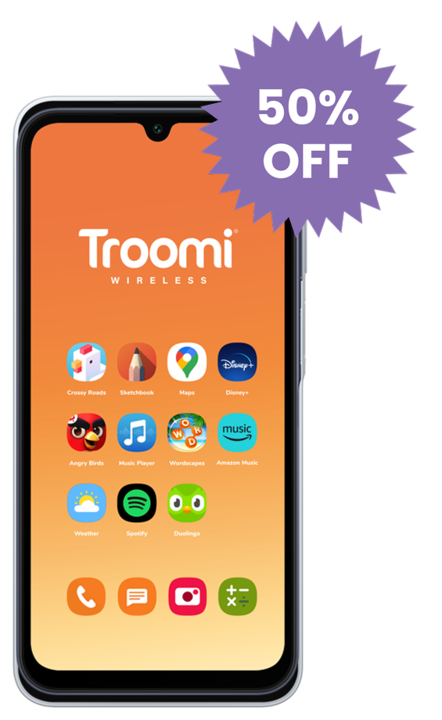Let’s try something. Imagine that you’re chatting with your kiddo. You’re telling them something important—maybe you’re talking about how cool Troomi phones are! Instead of listening, they repeatedly avoid eye contact and interrupt your impassioned speech. They might even pull out their phone and ignore you completely! Talk about a bad phone habit. You hate to say it, but it’s obvious that they won’t retain a word of what you say.
Were you feeling frustrated? I know I would be.
Now imagine the situation again, but this time picture your child maintaining eye contact. They nod along with what you’re saying and ask a clarifying question or two. If you’re lucky, they may even keep their hands off their phones entirely! Once you’re done talking, they respond with some thoughts of their own, and the conversation carries on for quite a while.
Feels good to know that they’re listening, right? Well, you can thank active listening skills for that one.
What Is Active Listening?
Active listening means giving your full, undivided attention to a speaker and making an effort to fully understand the sentiments of their speech. An active listener shows that they’re listening by focusing on the speaker, using positive body language, and asking clarifying questions that show interest.
Why Is Active Listening Important?
Active listening is a pretty vital skill. We call it a “soft skill,” meaning a core skill that is valuable in most situations—especially when a situation requires strong communication. Other soft skills include creative problem solving, time management, and social skills like teamwork. Helping kids develop a strong foundation of active listening is extremely important, as it will aid them at every stage of their lives.
Good listeners also make good communicators. By learning how to listen, kids also gain positive and productive conversation skills. In addition to the social benefits, active listening also helps kids:
- Better comprehend lessons
- Work more efficiently
- Develop a strong sense of self-reliance
- Retain information for far longer
Four Rules Of Active Listening For Kids
Now that we’ve had a refresher on what active listening is, you might be wondering how you can encourage your kids to practice and develop this skill. It’s easy: just sit down with your kids and review the four rules of active listening.
1. Give the speaker your full attention
Let’s face it, a distracted listener isn’t really a listener at all. To really understand what someone is saying, it’s important to put away all distractions and focus your attention on the other person. That means putting the phone away and tuning into the conversation in front of you!
Phones are the number one enemy of active listening, and phubbing is no joke. According to the Cambridge Dictionary, phubbing is “the act of ignoring someone you are with and giving attention to your mobile phone instead.” Encourage your kids to take a break from their phones; or else check out Troomi, the cool new phone that helps kids refrain from wasting time on technology!
Focusing your attention also means avoiding interrupting. Let the speaker finish their sentiments before you jump in, and don’t finish their sentences for them. Even if you have something really exciting to add, it can wait.
2. Use your body to show that you’re listening
When you’re talking to someone, how do you want them to look? If they were staring off into space or turned their back to you, you would be frustrated, right?
To show that you’re listening and absorbing information, make sure that your body reflects that attention. Point your body towards the speaker, and react to what they say. And don’t be afraid of a little eye contact! The old adage “the eyes are the windows to your soul” rings true in situations that require active listening and looking away from a speaker diverts your attention elsewhere.
Of course, many kids living with ADHD or autism prefer to avoid eye contact. It may feel unnatural for some of us to look directly into someone’s eyes, and in some situations it leads to stimulus overload. This is perfectly okay! Everyone’s situation is different, and nobody knows what your child needs more than you do.
3. Ask Questions and Give Feedback
Once the speaker has concluded, go ahead and respond! If you’re having trouble understanding what was said, don’t be afraid to ask clarifying questions. Asking questions and reiterating what was said is one of the best ways to absorb information. This also shows that you’re invested in what the other person is saying.
If you don’t have any questions, you can keep the conversation flowing by giving feedback or providing your own viewpoints.
4. Be an Empathetic Listener
It’s the golden rule: treat others how you want to be treated. In addition to giving the speaker your full attention, this rule means being an open-minded listener. Nobody wants to share their thoughts with someone that they fear might judge them, so be open to entertaining someone else’s ideas. Practice empathy and keep any judgments to yourself. When it’s your turn to talk, the other person will do the same.
Good Listeners Make Good Speakers
With a little help from teachers and parents, kids can easily grow into pretty spectacular communicators—especially once they know how to listen. For more parenting help, check out the Troomi blog! We update it every weekday with fun facts, interesting articles, and technology tips and tricks that you won’t want to miss.


